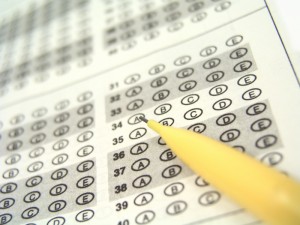Retesting and How It Can Help You Achieve the Score You Want
Standardized tests are usually stressful for students. This is understandable, as everyone knows that a strong (or weak) score can have a huge impact on college or private school admissions. To help improve test-taking performance, students and their parents will frequently turn to popular studying programs, such as test prep courses or test-specific study books. These programs can help, but if the resulting test score is still less than desired, the student and parents are left with a choice: keep studying and retake the test, or take a chance on admission officers liking the first score?
Sometimes, a strong GPA and a history of excellence in extra-curricular activities can make up for less-than-ideal test scores, but more often, families are choosing to retest. In recent years, half of high school students have taken the SAT more than once. There are many benefits to retesting, but waiting until after the first test administration may not give the student the best advantage. Rather, successful test-takers can take multiple practice tests, making their official test feel more like the third or fourth attempt.
Retesting has a positive impact on academic outcomes, generally. In a small but intensively explored subfield of psychology, researchers have found that retesting will improve an individual’s score by 2/3rds of a standard deviation, on average. If the student takes a third version of the test, they can expect to improve their scores by another 0.2 standard deviations. This trend can continue for several test administrations, with test scores usually reaching a plateau after the 4th or 5th test.
What does this mean? We’ll take the SAT as an example. The SAT is designed so that each year’s test-taking cohort will have an average score of 1000 and a standard deviation of 100. If a student received a score of 1130 on their first administration, they could retest for a potential score of 1200 on the second test, and possibly improve to a 1230 or 1240 on the third. Of course, these retest scores are not perfectly consistent, but even 50 more points could mean several dozen schools for which the student is now eligible to apply, making the extra studying and second test administration a worthwhile investment. In fact, test researchers unanimously support retesting because of the reliability of score improvements.
What if We Already Scheduled A Test Date Without Time For A Second Chance?
 Knowing that school applications have due dates, sometimes there is a desire to retest, but no time. Application due dates might be just a few weeks away, or maybe the family will be too busy leading up to applications. Another possible situation is when the parents know that a student could perform better on a test than they did on their first administration, but the student has no interest in further studying or test-taking. Feeling forced to study and retest could result in resentment, and the student could refuse to give their best effort on the second test. They may even score lower the second time around.
Knowing that school applications have due dates, sometimes there is a desire to retest, but no time. Application due dates might be just a few weeks away, or maybe the family will be too busy leading up to applications. Another possible situation is when the parents know that a student could perform better on a test than they did on their first administration, but the student has no interest in further studying or test-taking. Feeling forced to study and retest could result in resentment, and the student could refuse to give their best effort on the second test. They may even score lower the second time around.
As tutors, we see this situation frequently. Students might not be as success-driven as the parents. If a student feels that they did sufficiently well on their first test, or if they feel that their scores will allow them to gain admission to a “good enough” school, they will have no motivation to study for the test anymore, and they certainly won’t want to sit through a 3 hour exam again. Unfortunately, families may find themselves stuck in such a predicament after they receive their test results. By simulating retesting in advance through multiple practice runs, however, this can be avoided. If a student only has to sit for one “real” test, they cannot become resentful and unmotivated about the nonexistent second try.
Another unfortunate situation that happens fairly often with standardized testing is student anxiety. Many students do very well in class discussions and complete homework with top marks, but experience debilitating anxiety in a high-stakes test environment. Test anxiety is somewhat common in students, but some students have test anxiety so strong that it greatly inhibits their ability to perform on a test. Students, even very young students, recognize the importance of standardized tests. They might not know the stakes of the test, but they can hear the intonation of their parents’ and teachers’ when talking about ‘The Big Test’. They might form a mental impression of the test as a powerful force, one to be wary of. Sometimes they become so nervous about answering each question perfectly that they will spend an unnecessary amount of time on each problem. This extra time adds up over the test, and they find themselves only answering half of the questions on a section before they are forced to move on to the next section. Then their anxiety becomes even stronger. Now they want to answer each problem perfectly, but they need to hurry!
Retesting can help here too. Studies have shown that retesting can help decrease test anxiety by familiarizing the student with the test format, question types, and time constraints. Because test anxiety can be persistent, it may be helpful for the anxious student to take 4 or more practice tests. Once the student is truly comfortable taking their practice tests, they will be much more comfortable taking the real test. For this to work, it is imperative for the anxious student’s practice tests to be taken in an environment as similar to the actual test environment as possible.
How to Study For a Test Using the Science of Retesting
The most effective test preparation starts with taking a practice test, before any studying. The student takes a practice test in an authentic test environment with only a general knowledge of what the test assesses and how the test is set up, including amount of time to take each section. By taking a practice test without any studying, the student can see exactly what sections, and even what types of questions they need to spend the most time studying (e.g. big-picture questions in the reading section, math questions that combine geometry and algebra). Then, the student can focus their studying on those sections of the test.
After two or three months, the student can take another practice test. With their new knowledge, they should see drastic improvements. But even this test will show sections that could use improvement. Using this feedback to re-assess study goals, the student can then fine-tune their knowledge and test-taking skills in the months leading up to the test.
It could be helpful to take one more practice test two or three weeks before the actual test date. This final practice test’s main purpose is to make sure the student has a strong understanding of how to pace themselves during the test, because some students get into the habit of taking extra time to reason out problems while studying. Taking a final practice test less than two weeks before the actual test date could be detrimental, if the student is likely to fret over the questions they got wrong on their last practice test. Giving more time to study those concepts could help them alleviate this anxiety.
As a last recommendation, a student should feel free to stop studying a few days before the actual test. This will rest their minds, so they can approach their test with a rested and ready brain.
The Importance of a Simulated Test Environment
 When taking practice tests, it is important to have a test-taking environment that is similar to the environment the student will have for their actual test. Psychologists know that memories are formed by associations: you can remember more about a bonfire if you remember the way the smoke smelled and how the s’mores tasted. The more associations added to the study environment, the more the student will be able to remember during the test. In addition to this, if the student is comfortable taking a long test in a quiet, imposing room (such as the all-stone walls in most schools), then they will be more comfortable when they take their actual test.
When taking practice tests, it is important to have a test-taking environment that is similar to the environment the student will have for their actual test. Psychologists know that memories are formed by associations: you can remember more about a bonfire if you remember the way the smoke smelled and how the s’mores tasted. The more associations added to the study environment, the more the student will be able to remember during the test. In addition to this, if the student is comfortable taking a long test in a quiet, imposing room (such as the all-stone walls in most schools), then they will be more comfortable when they take their actual test.
To ensure a practice test environment that is similar to the actual test environment, it may be necessary for the student to take their test outside of the home. In fact, taking the test at home could be detrimental, as homes tend to be full of distractions. In addition, students often have a different attitude in their home environment compared to more studious environments. At school, they are used to sitting in a desk with a book open for long periods of time. At home, they may be tempted to leave their test to grab a snack, go to the bathroom, or think about what they’re going to do once they finish. This is understandable. After all, the home environment is where students go to relax after they leave school. Instead, students should take practice tests somewhere that they can focus completely. It helps for the room to look like a classroom. The library is a good example.
In addition to setting, the student should make sure to follow the test timing. A stop-watch could help, as could a friend or family member to act as the test proctor. The student should understand that the practice test needs to be taken seriously. This is the best mindset for them to have to prepare them for their big test.
Recap
Students often find it necessary to take a standardized test two or more times. Scores tend to improve when retesting, but time constraints and other factors could make it difficult to take multiple official tests. It is therefore more practical and efficient to simulate several retests before taking the real thing. By taking practice tests and approaching each one like the actual test, students can get all the benefits of retesting without the hassle of preparing and paying for more than one test administration.
Fast Facts
- Retesting is scientifically proven to improve test performance
- Performance can improve for three, four, and sometimes even five tests
- Take a practice test before any studying to see what areas need the most improvement.
- Work on those areas for two months.
- Take a second practice test no later than one month before the actual test.
- Re-assess studying needs based on this test score.
- As you reach the actual test date, broaden your studying to include all subjects.
- Remember to go easy the week leading up to the actual test. Anxiety is one of the leading causes of under-performing!
- Students prone to test anxiety should take as many practice tests as they need to become completely comfortable with the test.
















Pingback: How to Overcome Test Anxiety
Pingback: AP Exam Preparation: A Guide
Pingback: STAAR Tests Next Week – Is Your Child Ready?